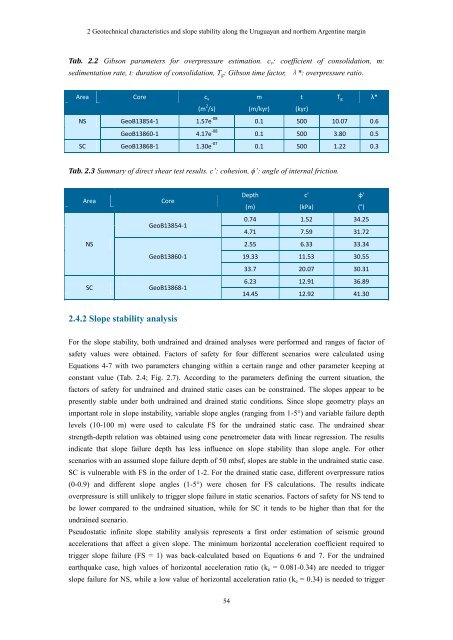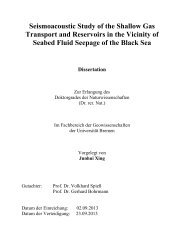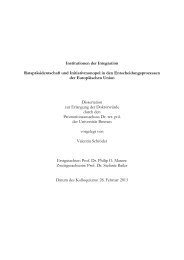Slope stability along active and passive continental margins ... - E-LIB
Slope stability along active and passive continental margins ... - E-LIB
Slope stability along active and passive continental margins ... - E-LIB
You also want an ePaper? Increase the reach of your titles
YUMPU automatically turns print PDFs into web optimized ePapers that Google loves.
2 Geotechnical characteristics <strong>and</strong> slope <strong>stability</strong> <strong>along</strong> the Uruguayan <strong>and</strong> northern Argentine margin<br />
Tab. 2.2 Gibson parameters for overpressure estimation. c v : coefficient of consolidation, m:<br />
sedimentation rate, t: duration of consolidation, T g : Gibson time factor, λ*: overpressure ratio.<br />
Area Core c v<br />
m<br />
t<br />
T g λ*<br />
(m 2 /s)<br />
(m/kyr) (kyr)<br />
NS GeoB13854-1 1.57e -08 0.1 500 10.07 0.6<br />
GeoB13860-1 4.17e -08 0.1 500 3.80 0.5<br />
SC GeoB13868-1 1.30e -07 0.1 500 1.22 0.3<br />
Tab. 2.3 Summary of direct shear test results. c’: cohesion, ϕ’: angle of internal friction.<br />
Area<br />
NS<br />
SC<br />
Core<br />
GeoB13854-1<br />
GeoB13860-1<br />
GeoB13868-1<br />
Depth<br />
(m)<br />
c'<br />
(kPa)<br />
φ'<br />
(°)<br />
0.74 1.52 34.25<br />
4.71 7.59 31.72<br />
2.55 6.33 33.34<br />
19.33 11.53 30.55<br />
33.7 20.07 30.31<br />
6.23 12.91 36.89<br />
14.45 12.92 41.30<br />
2.4.2 <strong>Slope</strong> <strong>stability</strong> analysis<br />
For the slope <strong>stability</strong>, both undrained <strong>and</strong> drained analyses were performed <strong>and</strong> ranges of factor of<br />
safety values were obtained. Factors of safety for four different scenarios were calculated using<br />
Equations 4-7 with two parameters changing within a certain range <strong>and</strong> other parameter keeping at<br />
constant value (Tab. 2.4; Fig. 2.7). According to the parameters defining the current situation, the<br />
factors of safety for undrained <strong>and</strong> drained static cases can be constrained. The slopes appear to be<br />
presently stable under both undrained <strong>and</strong> drained static conditions. Since slope geometry plays an<br />
important role in slope in<strong>stability</strong>, variable slope angles (ranging from 1-5°) <strong>and</strong> variable failure depth<br />
levels (10-100 m) were used to calculate FS for the undrained static case. The undrained shear<br />
strength-depth relation was obtained using cone penetrometer data with linear regression. The results<br />
indicate that slope failure depth has less influence on slope <strong>stability</strong> than slope angle. For other<br />
scenarios with an assumed slope failure depth of 50 mbsf, slopes are stable in the undrained static case.<br />
SC is vulnerable with FS in the order of 1-2. For the drained static case, different overpressure ratios<br />
(0-0.9) <strong>and</strong> different slope angles (1-5°) were chosen for FS calculations. The results indicate<br />
overpressure is still unlikely to trigger slope failure in static scenarios. Factors of safety for NS tend to<br />
be lower compared to the undrained situation, while for SC it tends to be higher than that for the<br />
undrained scenario.<br />
Pseudostatic infinite slope <strong>stability</strong> analysis represents a first order estimation of seismic ground<br />
accelerations that affect a given slope. The minimum horizontal acceleration coefficient required to<br />
trigger slope failure (FS = 1) was back-calculated based on Equations 6 <strong>and</strong> 7. For the undrained<br />
earthquake case, high values of horizontal acceleration ratio (k e = 0.081-0.34) are needed to trigger<br />
slope failure for NS, while a low value of horizontal acceleration ratio (k e = 0.34) is needed to trigger<br />
54
















